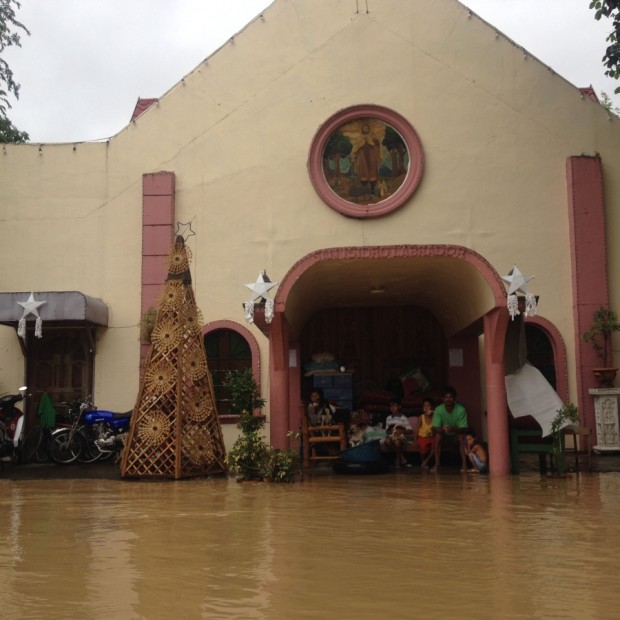
REFUGE FROM THE STORM The San Isidro Labrador Chapel took in two families from Barangay IbaO’Este in Calumpit town, Bulacan province, whose houses were flooded on Saturday due to the rains spawned by Typhoon “Nona.” The chapel had to suspend its 7 p.m.Mass to accommodate the evacuees. CARMELA REYES-ESTROPE
CALUMPIT, Bulacan—The traditional “Simbang Gabi,” the series of dawn Masses that lead up to Christmas Day, is celebrated at the San Isidro Labrador Chapel here at 7 p.m., instead of the usual 4 a.m., starting on Dec. 16.
But not on Saturday night, after the chapel became the refuge for two families, who fled the floods that buried their homes at Iba O’Este village here this week.
The chapel took in Rosie Coronel, 71, and her grandchildren when floodwater up to 3 feet swept through the town. She was soon joined by her neighbor, Vic Marcelino, 54, and his family.
Since then, they have been surviving on biscuits.
“We have not received relief goods yet because the floods are still high. We will get food as soon as the floods go down. But I hope those with the spirit of Christmas in their hearts would share with us some of their bounty,” Coronel said.
Because of the floods, the Sta. Lucia Chapel in Sta. Lucia village here also took in evacuees and had suspended its night Mass, according to officials.
On Saturday, floodwater spread to 116 villages in four Central Luzon provinces because of the rains spawned by Typhoon “Nona” (international name: Melor) and the northeast monsoon, according to the Regional Disaster Risk Reduction and Management Council (RDRRMC).
Six of the flooded villages were in Aurora, 15 in Bulacan, 49 in Nueva Ecija and 46 in Pampanga.
READ: Rains, floods torment PH
IMPROVISED COAT A homeless man wraps himself in aluminum foil as Tropical Depression “Onyok” entered the country and brought rains on Friday night. The storm weakened into a low pressure area on Saturday morning. MARIANNE BERMUDEZ
In Bulacan, 22,534 families from 18 villages in the towns of Calumpit, Hagonoy, Pulilan and San Miguel were affected by up to 6 ft of floodwater as of Saturday.
Water levels in Angat Dam rose to 214.44 meters above sea level (masl) at noon on Saturday, and the dam operators said they would release water at the rate of 60 cubic meters per second later at 5 p.m.
Water from the Pampanga River spilled onto the banks of San Isidro town in Nueva Ecija; San Agustin in Arayat, Sulipan in Apalit and Poblacion in Candaba, all in Pampanga, according to the Pampanga River Basin Flood Forecasting and Warning Center.
The RDRRMC said 8,809 families (43,052 people), mostly in Cabanatuan City and Bongabon town in Nueva Ecija, remained in 131 evacuation centers as of Saturday.
The Department of Public Works and Highways said 21 road sections in Aurora, Nueva Ecija, Pampanga and Tarlac were not passable to vehicles due to floods or landslides.
In Tarlac, corn crops worth P434.6 million were destroyed due to Nona’s rains. Nueva Ecija lost P233.9 million worth of rice to the floods while Pampanga lost P45.8 million worth of rice.
“It’s like [Typhoon] ‘Lando’ all over again. Water from upstream reached us but this time, it flowed down in one or two days. It used to come down in three to five days,” said Marcelo Lacap Jr., former vice mayor of Macabebe town in Pampanga.
Simplicio Pangilinan and his neighbors in Barangay Candelaria in Macabebe expected a quiet Saturday but floodwater from Nueva Ecija reached their village earlier at 7 a.m., forcing them to flee to high ground. Before noon, the water was 3 ft high, Pangilinan said.
Hundreds of residents in seven Macabebe villages and families living on the banks of the Pampanga River moved to the eastern section of the Masantol dike, where they pitched tents or stayed at the lone evacuation center built atop the dike.
RELATED STORIES
Rains to continue in several parts of PH as LPA enhances monsoon